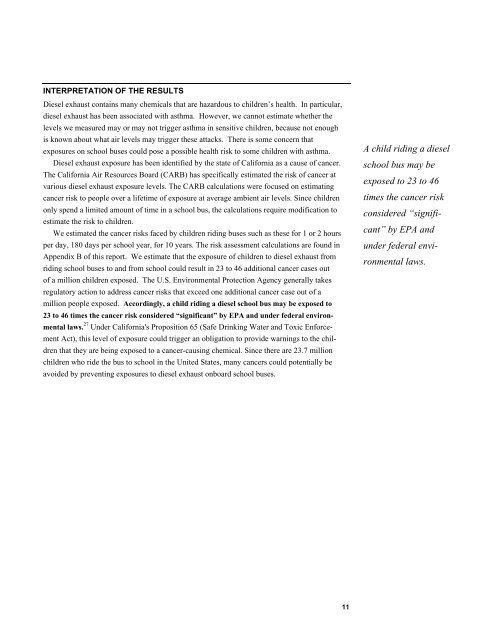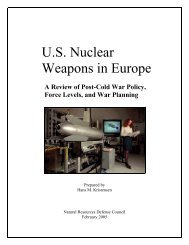NRDC: No Breathing in the Aisles: Diesel Exhaust Inside School ...
NRDC: No Breathing in the Aisles: Diesel Exhaust Inside School ...
NRDC: No Breathing in the Aisles: Diesel Exhaust Inside School ...
You also want an ePaper? Increase the reach of your titles
YUMPU automatically turns print PDFs into web optimized ePapers that Google loves.
INTERPRETATION OF THE RESULTS<br />
<strong>Diesel</strong> exhaust conta<strong>in</strong>s many chemicals that are hazardous to children’s health. In particular,<br />
diesel exhaust has been associated with asthma. However, we cannot estimate whe<strong>the</strong>r <strong>the</strong><br />
levels we measured may or may not trigger asthma <strong>in</strong> sensitive children, because not enough<br />
is known about what air levels may trigger <strong>the</strong>se attacks. There is some concern that<br />
exposures on school buses could pose a possible health risk to some children with asthma.<br />
<strong>Diesel</strong> exhaust exposure has been identified by <strong>the</strong> state of California as a cause of cancer.<br />
The California Air Resources Board (CARB) has specifically estimated <strong>the</strong> risk of cancer at<br />
various diesel exhaust exposure levels. The CARB calculations were focused on estimat<strong>in</strong>g<br />
cancer risk to people over a lifetime of exposure at average ambient air levels. S<strong>in</strong>ce children<br />
only spend a limited amount of time <strong>in</strong> a school bus, <strong>the</strong> calculations require modification to<br />
estimate <strong>the</strong> risk to children.<br />
We estimated <strong>the</strong> cancer risks faced by children rid<strong>in</strong>g buses such as <strong>the</strong>se for 1 or 2 hours<br />
per day, 180 days per school year, for 10 years. The risk assessment calculations are found <strong>in</strong><br />
Appendix B of this report. We estimate that <strong>the</strong> exposure of children to diesel exhaust from<br />
rid<strong>in</strong>g school buses to and from school could result <strong>in</strong> 23 to 46 additional cancer cases out<br />
of a million children exposed. The U.S. Environmental Protection Agency generally takes<br />
regulatory action to address cancer risks that exceed one additional cancer case out of a<br />
million people exposed. Accord<strong>in</strong>gly, a child rid<strong>in</strong>g a diesel school bus may be exposed to<br />
23 to 46 times <strong>the</strong> cancer risk considered “significant” by EPA and under federal environmental<br />
laws. 27 Under California's Proposition 65 (Safe Dr<strong>in</strong>k<strong>in</strong>g Water and Toxic Enforcement<br />
Act), this level of exposure could trigger an obligation to provide warn<strong>in</strong>gs to <strong>the</strong> children<br />
that <strong>the</strong>y are be<strong>in</strong>g exposed to a cancer-caus<strong>in</strong>g chemical. S<strong>in</strong>ce <strong>the</strong>re are 23.7 million<br />
children who ride <strong>the</strong> bus to school <strong>in</strong> <strong>the</strong> United States, many cancers could potentially be<br />
avoided by prevent<strong>in</strong>g exposures to diesel exhaust onboard school buses.<br />
11<br />
A child rid<strong>in</strong>g a diesel<br />
school bus may be<br />
exposed to 23 to 46<br />
times <strong>the</strong> cancer risk<br />
considered “significant”<br />
by EPA and<br />
under federal environmental<br />
laws.
















